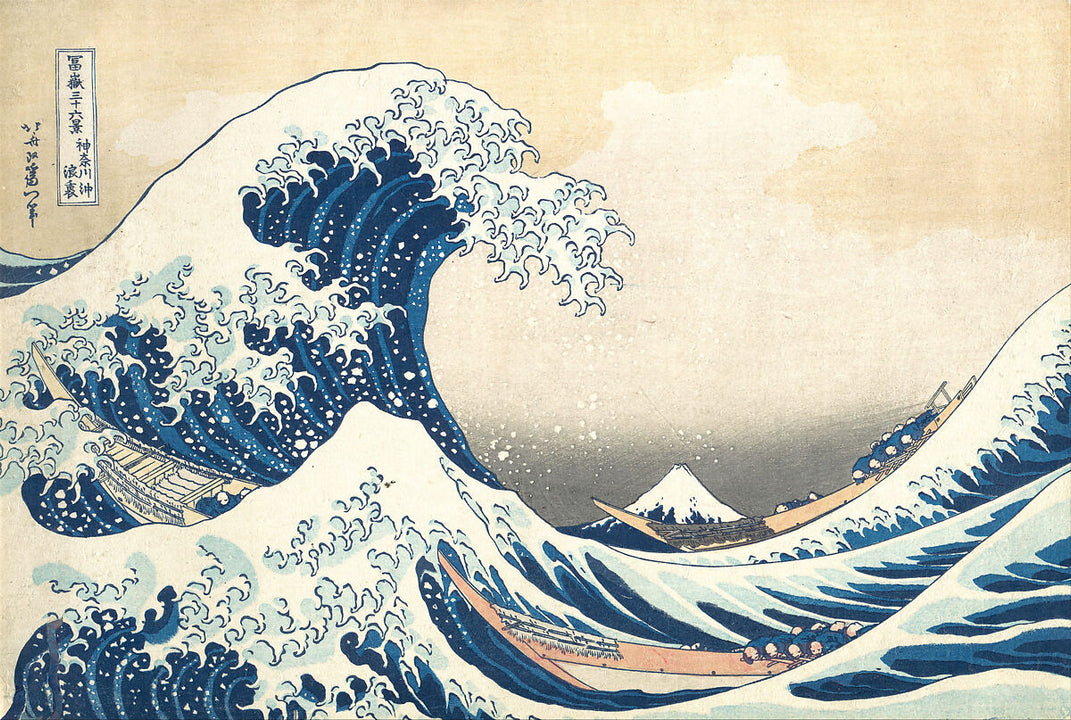
The Great Wave off Kanagawa, created by the Japanese artist Katsushika Hokusai, is one of the most recognisable images in art history. It was published around 1830 as the first in Hokusai’s series Thirty-Six Views of Mount Fuji, a collection of woodblock prints showcasing Japan's sacred mountain from different angles.
Hokusai and the Creation of The Great Wave
Born in Edo (now Tokyo) in 1760, Hokusai was the son of a shogun mirrormaker, likely born to a concubine. His interest in art began at the age of 6, by the age of 16 he was apprenticed as an engraver, and by 18, he joined the renowned Katsukawa school, mastering ukiyo-e, which translates to “pictures of the floating world.” Ukiyo-e prints flourished in Japan from the 17th to the 19th century, depicting everything from daily life to landscapes and popular cultural icons. Hokusai, however, broke new ground by focusing on the natural world, with The Great Wave showing Mount Fuji, dwarfed in the background, beneath a powerful wave.
The Woodblock Printmaking Technique
The Great Wave was created through the collaborative, multi-step process of woodblock printing, a technique that allowed for multiple copies of the same design - making artworks affordable and accessible.
First, the artist drew the initial design in ink, which was then pasted face down on a wooden block. The woodcarver meticulously chiselled away the negative space, leaving only the lines of the image in relief. This carved block was inked to print the outlines onto paper, while separate blocks were carved for each colour.
Each layer required precision. The colour blocks would be inked and pressed onto dampened paper, one after another, building up the scene in stages. This technique, known as nishiki-e, or "brocade printing," allowed for an intricate layering of hues, textures, and details. The result was a highly detailed, consistent print, but it came with limitations: each block wore down with use, leading to a reduction in quality over time. This wear is evident in surviving copies of The Great Wave, which vary significantly in clarity and colour due to repeated pressings.
Hokusai's Great Wave required extensive skill and coordination between artist, carvers, and printers, who all worked under the publisher's supervision. The success of each print hinged on the delicate balance of pressure, moisture, and ink, which gave each copy a unique quality even within the same edition.
The “Blue Revolution” with Prussian Blue
One of the most striking aspects of The Great Wave is its rich, intense blue - a shade known as Prussian blue, or bero ai (“Berlin indigo”) in Japan. Imported from Europe in the early 19th century, Prussian blue was far more stable and vibrant than the indigo (an ink made from the leaves of the Indigofera plant, which is prone to fading and was traditionally used in Japanese prints). Hokusai’s use of Prussian blue was revolutionary; it not only transformed the appearance of The Great Wave, but also influenced many artists in Japan. This “blue revolution” became a hallmark of Hokusai’s work, giving it a bold, lasting colour and intensity that caught the eyes of collectors and admirers both in Japan and later in Europe.
Hokusai’s publisher, Nishimuraya Yohachi, quickly realised the appeal of this new pigment and advertised it widely, making The Great Wave one of the first Japanese prints to feature Prussian blue. The initial 10 prints in Thirty-Six Views of Mount Fuji, including The Great Wave, were all printed with this vibrant blue and were so successful that the following prints in the series also featured the same predominantly blue aizuri-e style.
A Fusion of Eastern and Western Influences
The composition of The Great Wave reflects a synthesis of Japanese and European techniques. Hokusai incorporated European-style graphical perspective, giving the wave a sense of three-dimensional depth as it crashes toward the viewer, with Mount Fuji positioned serenely in the distance. This perspective, combined with the dramatic asymmetry, was rarely seen in Japanese prints and demonstrated Hokusai’s willingness to innovate. Western artists, particularly the Impressionists, were later captivated by these elements and adopted Japanese techniques of flat colour planes and bold outlines in their own work.
A Lasting Legacy and Global Icon
The Great Wave became immediately popular, with Hokusai’s publisher printing over 1,000 initial copies. Approximately 8,000 copies are estimated to have been printed in total, though only around 100 copies survive today, many held in museums such as the Metropolitan Museum of Art in New York and the British Museum in London.
Described as “possibly the most reproduced image in the history of all art,” The Great Wave off Kanagawa has had an impact that spans continents and centuries. From posters to clothing, it continues to inspire viewers and artists alike with its beauty, technical mastery, and dynamic composition.
Paint our version of The Great Wave
Here at Paintvine you can paint a simplified version of this iconic artwork! Book your spot to recreate Hokusai’s famous wave, using our unique adaptation with flat blocks of colour to mimic the woodblock print aesthetic. Join us to paint this powerful scene, and immerse yourself in the art and history of one of Japan’s most celebrated masterpieces!

